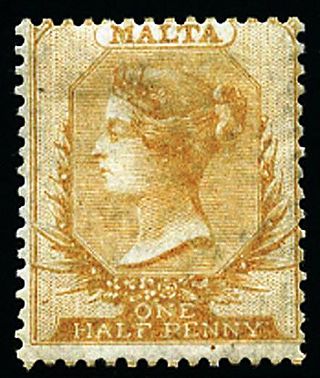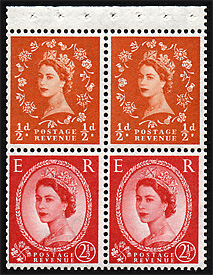
Smilers is the name given to Britain's personalised stamps. Personalised stamp sheets (or P-Stamps) were first issued by Australia Post in the summer of 1999.

Smilers is the name given to Britain's personalised stamps. Personalised stamp sheets (or P-Stamps) were first issued by Australia Post in the summer of 1999.
Personalized stamp sheets were first issued by the Post Office (subsequently renamed Royal Mail) to coincide with The Stamp Show 2000, Britain's international stamp exhibition held in May 2000 at Earls Court. [1]
The "Smilers" A4-sized stamp sheets contained ten se-tenant "smiles" stamps with a generic label design. Personalised versions of these stamp sheets were made available to the public at special photo-booths throughout the 2000 Stamp Show held in London. The cost for a single sheet of ten stamps and personalised photo labels was £5.95 (£10.00 for two sheets; equivalent to a premium of £4.80 on the cost of twenty stamps). The cost in March 2008 was £13.50 per single sheet of twenty first-class stamps or £12.50 for two or more sheets (a premium of £6.70 over face value). [2]
This service proved popular to visitors attending the show, arguably due to its novelty value, but later attempts to continue the Smilers sheet format with other stamp designs was initially not so popular. This can be attributed to the novelty value having worn off and the premium charged above face value. As a result, the subsequent four or five Smilers sheet issues are now scarce. The 2000 Christmas sheets featured designs of a robin in the aperture of a pillar box and Father Christmas holding a Christmas cracker that had first appeared in 1995 and 1997. The 2001 sheets were even less popular when issued, as they featured those same designs again, the only difference being the addition of the word "Smilers" and the name Consignia in place of Post Office on the selvage.
As an alternative to the personalised version, using a photo or image provided by the purchaser, Royal Mail also produce sheets with pre-designed "generic" labels at a much lower premium.
In 2002 the Post Office registered the name Smilers as their branded name for their personalised stamp service. The name derives from its use on the first British personalised stamp sheet of a set of 10 stamps that first appeared in a Greetings Booklet issued in 1990. They were referred to as "Smiles" stamps because they featured famous smiles with which people could identify. The Greetings Booklet comprised a pane of 10 stamps and a separate sheet of labels with greetings such as "Hello", which could be affixed separately on the envelope alongside the stamp, in effect the forerunner of the se-tenant stamp sheets issued at The Stamp Show 2000.
The stamp designs are taken from the 1990 Greetings booklet stamps.

A postage stamp is a small piece of paper issued by a post office, postal administration, or other authorized vendors to customers who pay postage. Then the stamp is affixed to the face or address-side of any item of mail—an envelope or other postal cover —which they wish to send. The item is then processed by the postal system, where a postmark or cancellation mark—in modern usage indicating date and point of origin of mailing—is applied to the stamp and its left and right sides to prevent its reuse. Next the item is delivered to its addressee.
A first day of issue cover or first day cover (FDC) is a postage stamp on a cover, postal card or stamped envelope franked on the first day the issue is authorized for use within the country or territory of the stamp-issuing authority. Sometimes the issue is made from a temporary or permanent foreign or overseas office. Covers that are postmarked at sea or their next port of call will carry a Paquebot postmark. There will usually be a first day of issue postmark, frequently a pictorial cancellation, indicating the city and date where the item was first issued, and "first day of issue" is often used to refer to this postmark. Depending on the policy of the nation issuing the stamp, official first day postmarks may sometimes be applied to covers weeks or months after the date indicated.
This is a list of philatelic topics.

A postage stamp booklet is a booklet made up of one or more small panes of postage stamps in a cardboard cover. Booklets are often made from sheets especially printed for this purpose, with a narrow selvage at one side of the booklet pane for binding. From the cutting, the panes are usually imperforate on the edges of the booklet. Smaller and easier to handle than a whole sheet of stamps, in many countries booklets have become a favored way to purchase stamps.

This is an overview of the postage stamps and postal history of Australia.

A greeting card is a piece of card stock, usually with an illustration or photo, made of high quality paper featuring an expression of friendship or other sentiment. Although greeting cards are usually given on special occasions such as birthdays, Christmas or other holidays, such as Halloween, they are also sent to convey thanks or express other feelings.

A personalised (or personalized) stamp is a postage stamp on which, for a fee, an image and/or text of the purchaser's choosing may be placed. The stamps vary from country to country, and while some are normal stamps with a personalised label on the left attached by perforations, elsewhere the stamps are more properly regarded as one-piece personalised meter stamps with a colourful design next to the indicia. Stamps produced by Zazzle.com for the United States, for instance, are one-piece, self-adhesive with die cut margins to emulate perforations, and visually very similar to normal United States postage stamps, except for the addition of an information-based indicia (IBI) encoded by little black and white squares along one edge. A serial number appears next to the IBI.

A Christmas stamp is a postage stamp with a Christmas theme, intended for use on seasonal mail such as Christmas cards. Many countries of the world issue such stamps, which are regular postage stamps and are usually valid for postage year-round. They usually go on sale some time between early October and early December, and are printed in considerable quantities.

The Machin series of postage stamps is the main definitive stamp series in the United Kingdom, used since 5 June 1967. It is the second series to figure the image of Elizabeth II, replacing the Wilding series. The last issue was on 4 April 2022, four months before her death on 8 September.

The postage stamps of Ireland are issued by the postal operator of the independent Irish state. Ireland was part of the United Kingdom of Great Britain and Ireland when the world's first postage stamps were issued in 1840. These stamps, and all subsequent British issues, were used in Ireland until the new Irish Government assumed power in 1922. Beginning on 17 February 1922, existing British stamps were overprinted with Irish text to provide some definitives until separate Irish issues became available. Following the overprints, a regular series of definitive stamps was produced by the new Department of Posts and Telegraphs, using domestic designs. These definitives were issued on 6 December 1922; the first was a 2d stamp, depicting a map of Ireland. Since then new images, and additional values as needed, have produced nine definitive series of different designs.

A Presentation Pack typically contains a full set of a new stamp issue, produced for philatelists and stamp collectors. It normally comprises a folded card containing detailed notes about the stamps, a card with clear strips for holding the actual stamps, all held within a clear sleeve. The packs are usually sold at a price a little above the stamps' face value.

The postal history of Malta began in the early modern period, when pre-adhesive mail was delivered to foreign destinations by privately owned ships for a fee. The earliest known letter from Malta, sent during the rule of the Order of St John, is dated 1532. The first formal postal service on the islands was established by the Order in 1708, with the post office being located at the Casa del Commun Tesoro in Valletta. The first postal markings on mail appeared later on in the 18th century.

Definitive postage stamps of Ireland are the regular series of definitive postage stamps issued by the Irish Free State between 1922 and 1937 and by Republic of Ireland since 1937. Nine distinctly different series of designs have been released; additionally the watermark was changed for two issues and the currency was changed on three occasions while the designs remained the same.
Jeffery Matthews is a British artist, specialising in postage stamp design from 1959 to 2007. He conceived the Machin definitive series' colour palette in the mid-1980s.

The Wildings were a series of definitive postage and revenue stamps featuring the Dorothy Wilding photographic portrait of Queen Elizabeth II that were in use between 1952 and 1971. The Wildings were the first and only British stamps to feature graphite lines on the back, and the first to feature phosphor bands on the face – both aids to automation. The stamps were also the first British pictorial high value stamps and the first to include regional emblems.

Mauritius, a small island in the southwest Indian Ocean, is important to the world of philately for a number of reasons. Its first two postage stamps issued in 1847, called the "Post Office" stamps, are of legendary rarity and value. They were the first stamps issued in any part of the British Empire outside of Great Britain. The unique cover bearing both “Post Office” stamps has been called "la pièce de résistance de toute la philatélie" or "the greatest item in all philately". The cover was sold at auction, in Zurich, on 3 November 1993, for 5.75 million Swiss francs, the equivalent of about $4 million – the highest price ever paid for a single philatelic item up to that time. In addition, Mauritius is well known for the subsequent locally produced issues known as "primitives," also prized by collectors.

Health stamps are a long-running series of charity stamp issued by New Zealand which include a premium for charitable causes in addition to the charge for postal service. Health stamps were issued annually from 1929 to 2016.

Se-tenant stamps or labels are printed from the same plate and sheet and adjoin one another, unsevered in a strip or block. They differ from each other by design, color, denomination or overprint. They may have a continuous design. The word "se-tenant" translates from French as meaning "joined together" or "holding together".

Jennifer M. Toombs was a notable British postage stamp designer.